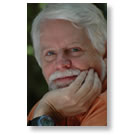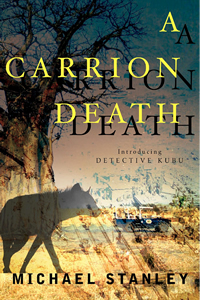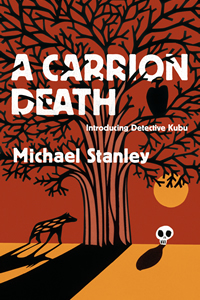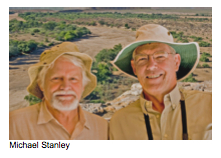Hello, readers –
Anne here, with a real treat for you today: a guest blog by Stanley Trollip, one-half of the writing team readers will soon know as Michael Stanley.
I’m always thrilled when a good author gives in to my blandishments to write a guest post: since the road from concept to publication is often long and arduous for even the best and most market-savvy of aspiring writers, it’s great to see one of us — or, in this case, two of us — make it at last!
And how! Their first novel, A Carrion Death, will be released in the US and UK this coming week, so I’m tickled the proverbial pink that Stan was willing to take time out of his hectic signing schedule to give us here in the Author! Author! community some tips on writing collaboratively, the revision process (appropriate timing, eh?), and the about-to-be-published life in general.
The book sounds like a hoot, incidentally. Here’s the low-down:
Smashed skull, snapped ribs, and a cloying smell of carrion. Leave the body for the hyenas to devour—no body, no case. But when Kalahari game rangers stumble on a human corpse mid-meal, it turns out the murder wasn’t perfect after all. Enough evidence is left to suggest foul play. Detective David “Kubu” Bengu of the Botswana Criminal Investigation Department is assigned to the case. From the sun-baked riverbeds of the Kalahari to the highest offices of an international conglomerate, he follows a blood-soaked trail in search of answers. Beneath a mountain of lies and superstitions, he uncovers a chain of crimes leading to the most powerful figures in the country—influential enemies who will kill anyone in their way.
Sounds exciting, eh? Should any of you be planning to write query letters in the foreseeable future, THAT’s what a terrific, attention-grabbing summary paragraph looks like.
A Carrion Death is already available for pre-order on Amazon for US readers, Amazon for Canadian readers, and Amazon in the UK.
I mention all three, not just to make ordering easier, but also because the first Amazon is carrying editions with the left-hand book cover above, and the other two are offering versions with the cover on the right. Go figure.
Just between us, this book — whatever cover may happen to be on it — has been receiving some pretty stellar advance reviews. Seriously, Publishers Weekly doesn’t give starred reviews to just any book — this is the stuff of which writerly daydreams are made. Take a gander:
“The intricate plotting, a grisly sense of realism and numerous topical motifs …make this a compulsively readable novel.”
(Publishers Weekly, February 25th, 2008)“[A] fast-moving story… Rich with the atmosphere of modern Botswana, and peopled with interesting and well-drawn characters, this is an exciting debut.” (Booklist, February 1, 2008)
“This well-plotted debut introduces a new mystery series and will enthrall readers.” (Library Journal, March 1, 2008)
“The police procedural story line is superb…” (Genre Go Round Reviews, February 9, 2008)
May we all be blessed with reviews that good!
For all of these reasons, I’m pretty psyched to welcome our guest blogger today. Take it away, Stan!
It’s an exciting month for us. Our first mystery novel, A Carrion Death, introducing Detective Kubu will be launched by HarperCollins on the first of April in Minneapolis. Two days later, Headline releases it in the UK. The us is Michael Sears and Stanley Trollip:
and we use the (rather obvious) pen name of Michael Stanley:
I divide my time between Minneapolis and the coastal town of Knysna in South Africa, while Michael lives in Johannesburg. So this collaboration is long distance. Many people are surprised by a successful jointly written mystery story at all, let alone one where the authors are at least a thousand miles apart most of the time. Yet we’re told — even by people who know us well — that it is hard to attribute a piece of writing to one of us or the other, and that the flow is smooth and has no disturbing changes of style. So how did we do it?
Well, let me say up front that when we started, we knew little about writing fiction and, if we had understood all the predicted problems around writing collaboratively, we might not have embarked on this adventure! But on our travels, we’d been talking about a detective story set in the African bush for many years, and when Michael suddenly wrote a chapter rather out of the blue in the middle of 2003, it seemed like great fun.
And that’s how we approached the whole project: having fun together. We had no great expectation of the novel ever being published, and we wrote and rewrote it many times as we started to learn the ropes of working together and, more importantly, as we developed our writing and plotting skills.
It was a dreadfully inefficient process. We each wrote several chapters that the other didn’t like at all resulting in a lot of material being thrown away. The plot kept changing of our own volition, as well as the result of the invaluable input of professionals like our agent, Marly Rusoff, and our editors at HarperCollins and Headline. We were also very fortunate to get honest (and often painful) feedback from some of our reader friends. More changes! The book seemed to get too long, too fast, too slow.
I guess that most new novelists experience these types of problems. The wonderful thing about collaboration with someone you know and trust is that you have an immediate, interested and very critical reader for everything you write. Education theory is clear on the value of collaborative learning. Why should learning to write fiction be an exception? Both of us have experience with collaborative writing of non-fiction; both of us enjoyed it and were reasonably successful. So, again, why should fiction be an exception?
So let me try to answer the question of how we write together. Of course, collaborative work is going to depend on the partners, their styles, and interests. Still, there are a few ground rules which must be pretty universal:
— You have to leave your ego behind. You have to be willing to take immediate and possibly quite sharp criticism of your ideas, your characters and your writing. However, wouldn’t you prefer a partner provide such feedback, rather than an editor or a critic?
— You need to agree on the basic direction and structure of the plot. Of course, the characters will take over to some extent, but you need to know generally where you’re heading.
— You have to watch carefully that the characters behave consistently, whoever’s writing. The issue we had was that as we developed characters, their early appearances became less convincing. This must be a problem facing most authors writing a first novel.
I’ll describe how we went about writing our second Detective Kubu novel — The Second Death of Goodluck Tinubu. It’s due for relese in 2009. By the time we started, we had rubbed off most of the rough edges that arose from our inexperience rather than from anything to do with our collaboration. A Carrion Death will see the light of day almost five years after we started writing it, Second Death will be closer to three. That is the benefit of experience.
Our major lesson was to structure the plot really carefully first. The synopsis we sent to our agent when we started the book is still close enough to describe the final version, although the details have changed quite considerably as the characters and texture developed. We spent sometimes frustrating weeks writing nothing and talking the plot through together.
Here it was important to be together and brainstorm, while always being ready to catch an inconsistency arising from the other person’s enthusiasm for his idea. Michael has a habit of killing off characters when we paint them into a corner; I try to resist this for humanitarian reasons if nothing else!
The writing we divide, each picking up pieces where we have ideas and mind pictures of how the scene will work. Obviously this means working on different chapters of the book at the same time. That’s not a problem as long as it’s agreed how the piece will fit with the overall structure. And the great thing is that as soon as the piece is written, there is someone excited and keen to read it immediately, albeit with a critical eye and —track changes’ generating washes of colored notes.
All of that needs to be discussed and worked through — from the basic approach to the exact wording — and so the piece goes through multiple drafts. Skype is a huge boon here; hours of discussion take place over each chapter — sometimes with Michael in South Africa and me in the USA. Email is a given; it would be unthinkable to do this by fax, let alone snail mail!
So it’s put together, we have a draft of a part and settle down to read it, seeing how it flows, how the characters work, whether the plot moves forward. Often we will each find different things needing improvement. We change and polish, and Skype runs hot.
At the end we look back and think about what fun we’ve had and how lucky we are that other people seem to share that. And we wonder why one would want to write fiction alone?
We are also often asked how we went about getting an agent. Did we have one lined up before we started writing? Did we submit our book without letting people know Michael Stanley was, in fact, two people? Or were we up-front about the dual authorship?
We began writing without any thought of agents. After all we were doing it for fun. And my research led me to believe that no agent would be interested in considering a partial manuscript from an unknown author. So it was only when we had a decent draft of the book that we started looking for an agent. And we did so with a clear plan in mind.
We devised our plan by putting ourselves in the position of an agent. Our mental picture was of an agent’s desk piled high with manuscripts — an overwhelming sight each morning. We hypothesized that the agent would then try to reduce the piles as quickly as possible by discarding any manuscript that had a “problem”. A generic query letter? Into the trash! A query letter that was too long or didn’t provide the specified information? Into the trash! A query line that didn’t grab attention? Into the trash! A typo? Into the trash! A dog-eared page? This manuscript had been sent to someone else before coming here! Into the trash!
And so on. Our philosophy was to give an agent no excuse for trashing our submission without reading it. We realize that our mental picture may be incorrect, but it forced us into paying meticulous attention to detail. Every query letter we sent out met every requirement or guideline of the agent. No exceptions.
We were also upfront about Michael Stanley being the pen name of two authors. We had nothing to hide and, if anything, people would be intrigued by fiction being written collaboratively. So our query letter started “We would like to bring to your attention our recently completed mystery novel, entitled A Carrion Death.”
For the most part we approached agents who accepted queries via email. We sent out about 40 queries in a couple of waves. About a third of the agents never bothered to respond. About a third were immediately not interested. And about a third wanted to read the first few chapters.
We ended up having two agents wanting to represent the book. We were so fortunate. We ended up choosing the wonderful Marly Rusoff as our agent. And she has done us proud with contracts with HarperCollins, JC Lattès in France, and Sonzogno in Italy. ref=”http://www.crime-files.co.uk/”>Headline in London bought the UK rights from HarperCollins.
Now the waiting begins. Will readers enjoy our tale? Will they want more? Or is our only reward going to be that Michael and I had so much fun writing together and are better friends now than when we started?





 Michael Stanley is the writing team of Michael Sears and Stanley Trollip, both South Africans by birth. Both are retired professors who have worked in academia and business, Sears in South Africa and Trollip in the USA. Their love of watching the wildlife of the African subcontinent has taken them on a number of flying safaris to Botswana and Zimbabwe. A Carrion Death is their first novel.
Michael Stanley is the writing team of Michael Sears and Stanley Trollip, both South Africans by birth. Both are retired professors who have worked in academia and business, Sears in South Africa and Trollip in the USA. Their love of watching the wildlife of the African subcontinent has taken them on a number of flying safaris to Botswana and Zimbabwe. A Carrion Death is their first novel.
 South African-born Stanley Trollip lived in the United States from 1971 until his retirement in 2003. Now he divides his time between Minneapolis and Knysna, South Africa. As a professor he was interested in how computers can facilitate teaching and learning. He is also a pilot and has enjoyed many flying safaris through the countries of southern Africa.
South African-born Stanley Trollip lived in the United States from 1971 until his retirement in 2003. Now he divides his time between Minneapolis and Knysna, South Africa. As a professor he was interested in how computers can facilitate teaching and learning. He is also a pilot and has enjoyed many flying safaris through the countries of southern Africa.
 Michael Sears was born in Johannesburg, and grew up in Cape Town and Nairobi, Kenya. He is a mathematician by training. At the end of 2007, he retired from the Anglo-American corporation where he managed a remote-sensing group. He has traveled widely in Southern and Central Africa, with Botswana always being a special favorite.
Michael Sears was born in Johannesburg, and grew up in Cape Town and Nairobi, Kenya. He is a mathematician by training. At the end of 2007, he retired from the Anglo-American corporation where he managed a remote-sensing group. He has traveled widely in Southern and Central Africa, with Botswana always being a special favorite.




Great advice and information for fiction writers, whether they write singly or in collaboration.
(And if others in the Author! Author! community want to know, just a hour or so ago, I finished the first draft of my second novel, SAILING DANGEROUS SEAS!)
At the same time, while Anne is talking about feedback and feedback reception, my writing group met yesterday and went over the second chapter of BEYOND THE OCEAN’S EDGE. Collectively we found a few things that should be revised. I’m fast becoming a believer that nothing is set in stone until it’s on the bookstore shelf!
Dave
HOORAY, DAVE!!!!!
Sounds like a fantastic book, I can’t wait to read it!
What a great interview and story. Congratulations to Mr. Trollip and Mr. Sears! Their book sounds wonderful. A good reminder that hard work and persistence do matter.
I lived in Namibia for 5+ years and am familiar with their part of the world. I still miss it. Knysna, Mr. Trollip’s half-time, seaside home town is gorgeous!
I wonder if they are planning any more collaborations.
Thanks, Susan. I may like Namibia even more than Botswana. Our second book, The Second Death of Goodluck Tinubu, is at our editor.